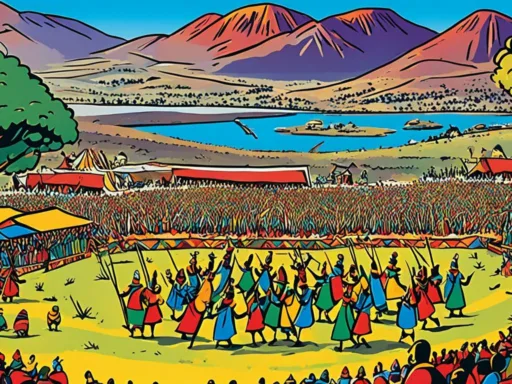Often, we cling to the notion that there’s an ideal season to witness the allure of a place like Israel, a country where every stone echoes ancient tales and every shore invites sun-kissed serenity. Yet, suppose one dares to peel back the layers of Israel’s diverse seasons. In that case, they might discover that the Best Time to Visit Israel is a mosaic of moments, each colored by its unique cultural and natural beauty. Whether you’re a pilgrim seeking the solemnity of sacred sites or a traveler eager to indulge in the Mediterranean’s embrace, Israel’s vacation season offers varied splendors. In this guide, we share invaluable Israel travel tips to ensure your Israel trip planning yields an excursion woven with the richness of historical significance and the zest of contemporary life.
Key Takeaways
- Understanding the seasonal climate and cultural events can significantly enhance your Israel experience.
- Spring and autumn are generally favorable for comfortable travel and sightseeing.
- Each season in Israel offers a distinct perspective, from vibrant festivals to peaceful historical tours.
- Off-peak months may offer quieter visits to normally bustling sites.
- Adventures await throughout the year, from beach lounging in summer to tranquil meditation at holy sites in winter.
- Your travel objectives should guide you in choosing the best time for your Israel trip.
Understanding Israel’s Climate and Best Months to Tour
Embarking on a journey to Israel calls for an in-depth exploration of the country’s diverse climate to optimize your travel experience. Whether you’re seeking sun-kissed beaches or a serene pilgrimage, certain months enhance the allure of this historic land. Here’s your essential Israel weather guide, highlighting the best months to visit Israel and aiding in Israel trip planning.
Israel’s stretches of Mediterranean coastline offer idyllic conditions for beach enthusiasts during the extended summer months. From buzzing beach bars to tranquil sunsets, the period from May to early October is when Israel’s coastal towns pulse with life beneath clear blue skies.
For those keen on architectural marvels and the footsteps of history, Spring – spanning March and April – and Autumn – around October to November, present milder climates. These seasons afford comfortable exploration through Israel’s tapestry of ancient civilization, without the extremities of summer heat.
Travelers seeking solitude in the Holy Land will find winter, from December to February, to be uniquely appealing. This introspective time offers a quieter atmosphere, ideal for those looking to immerse themselves in Israel’s storied past against a cooler but peaceful backdrop.
| Season | Months | Climate | Recommended Activities |
|---|---|---|---|
| Spring | March – April | Mild | Historical site tours, city walks |
| Summer | May – Early October | Hot, Sunny | Beach activities, nightlife |
| Autumn | October – November | Mild to Cool | Outdoor cultural festivals, winery visits |
| Winter | December – February | Cool to Cold | Spiritual tours, museum visits |
To fully reap the benefits of Israel’s dynamic seasons, consider meshing your trip’s objective with the respective climate. Beach leisure, spiritual journeys, or historical exploration – each has its time under the Israeli sun. May this guide serve as the cornerstone of your upcoming adventure, shedding light on the seasonal rhythm of Israel’s enchanting landscape.
Cultural and Religious Highlights During Israel’s Peak Season
As spring awakens, Israel ushers in its peak season with a flourish of cultural festivities and religious observance. Travelers from around the globe converge to partake in time-honored rituals, while the country’s urban landscapes teem with life, reflecting a perfect fusion between ancient traditions and contemporary vibrancy.

Partake in Major Religious Festivals
Israel, imbued with deep religious roots, blossoms during the spring as it hosts some of the most significant spiritual gatherings globally. The Easter celebrations and the Jewish Passover stand as monumental events, providing a profound insight into the collective heart and soul of this historic land.
- Experience the Solemn Processions within Jerusalem’s venerable walls.
- Witness the vibrant community celebrations and ancient customs come to life.
Exploring Israel’s Bustling Cityscapes
In tandem with the spiritual jubilations, cities like Tel Aviv and Haifa burst into a spectrum of color and activity. Tel Aviv’s Rothschild Boulevard and Neve Tzedek district showcase the epitome of modernity, juxtaposed against the historic quarter of Jaffa, renowned for its art-filled ambience and bustling markets.
Discover the serene escape of Haifa’s Baha’i Gardens—a terraced haven offering tranquility above the urban chatter.
The dynamic nature of these cityscapes during Israel’s vacation season emblematically represents the nation’s rich tapestry, weaving together multisensory experiences—both old and new—for travelers.
| City | Cultural Experience | Historical Significance |
|---|---|---|
| Tel Aviv | Art galleries, unique architecture, and cosmopolitan nightlife. | The timeless narrative of Jaffa, an ancient port city with archeological wonder. |
| Haifa | Multicultural festivals and a thriving culinary scene. | The Baha’i Gardens, symbolizing the unity and serenity of this bustling city. |
Insightful Israel travel tips suggest that to truly immerse oneself in the intricate layers of Israel’s cultural canvas, visitors should engage with both the solemnity of its religious observances and the pulsating life of its cities. The peak season weaves a narrative that invites curiosity and promises a journey of profound discovery.
Best Time to Visit Israel for a Biblical Journey
When it comes to Israel trip planning, pinpointing the Best Time to Visit Israel for a biblical excursion demands careful consideration. The beauty of a Biblical tour of the Holy Land lies not just in the ancient tales etched into its soil but also in the ability to immerse oneself in contemplation without the interruptions of dense crowds.
The off-peak season brings forth a unique tranquility over Israel’s storied landscapes, enhancing the experience at each venerable site. This period offers a solemn peace at renowned locations like the Church of the Holy Sepulchre, the contemplative ambiance on the Mount of Olives, and the spiritual serenity along the shores of the Sea of Galilee.
| Site | Significance | Recommendation |
|---|---|---|
| Church of the Holy Sepulchre | Revered as the site of Jesus’s crucifixion and tomb. | A quiet visit allows for personal meditation and reflection. |
| Mount of Olives | Historical site with sweeping views of Jerusalem. | Attend a small group tour for a detailed historical overview. |
| Sea of Galilee | Witness to numerous biblical miracles. | Join a boat tour to gain a new perspective on biblical stories. |
| Bethlehem’s Church of the Nativity | The birthplace of Jesus Christ. | Visit during early hours for a more intimate experience. |
The cooler months magnify the spiritual essence of these locales and allow for a seamless journey through time. Thoroughly organized tours are frequently available, designed to deliver educational insights and foster a connection with Christianity’s earliest beginnings.
Travel through the Holy Land during this season is to walk the paths of biblical figures under the same sky, yet in a world transformed by time.
Adventures by the Mediterranean: Israel’s Coastal Beauty
Israel’s shoreline is a treasure trove of experiences, especially during the balmy days from May to October. This period is marked by the idyllic Israel weather guide for beach enthusiasts, where the sun-kissed sands become a canvas for sunbathers, the gentle waves beckon swimmers, and the cool sea breeze enlivens the spirits of those seeking peace away from the bustling city life.
Enjoying the Sands of Tel Aviv’s Beaches
Tel Aviv’s coastline is symbolic of Israel’s vibrant Mediterranean beaches. Join the locals in their beloved pastime of beach volleyball, indulge in the thriving beach café culture, or simply soak in the warmth of the golden sun. For those preferring to travel when the bustle subsides, off-peak travel times in Israel present an opportunity to enjoy these scenic spots with more tranquility.

Haifa’s Bahai Gardens: A Terrace of Serenity
Further north lies the city of Haifa, home to the majestic Bahai Gardens. These stunning terraces exude a sense of serenity, inviting visitors to meander through the greenery and enjoy the horticultural artistry that is characteristic of the region. An escape here during spring or fall months is highly recommended, with the weather being pleasantly mild.
Below is a table with typical experiences one might expect during different times for these two distinct Mediterranean gems:
| Feature | Tel Aviv Beaches | Bahai Gardens in Haifa |
|---|---|---|
| Best Visiting Months | May – October | March – April; October – November |
| Activities | Swimming, sunbathing, watersports | Guided tours, photography, meditation |
| Atmosphere | Lively and vibrant | Tranquil and reflective |
Whether it’s engaging in the dynamic life on the beaches of Tel Aviv or embracing the calm within Haifa’s terraced paradise, Israel’s Mediterranean coast is full of contrasting experiences that can cater to every traveler’s whims. It all comes down to picking the right time, packing your sunscreen, and setting out to create unforgettable memories under the Israeli sun.
Off-Peak Seasons: Quieter Visits to Israel’s Holy Sites
When planning a trip to Israel, consider the tranquil beauty of off-peak travel times in Israel; a period that promises quieter streets and more intimate experiences. While most visitors target the peak seasons for warmer weather, the months of late autumn and winter offer a rare opportunity to explore Israel’s solemn treasures at a leisurely rhythm and in peaceful solitude.

Experiencing Jerusalem Without the Crowds
Jerusalem, a city steeped in profound religious significance, becomes a sanctuary for reflection during the off-peak season. Walking through its ancient pathways and exploring sacred sites like the Western Wall, Temple Mount, and the storied Via Dolorosa offer a different experience—one marked by reverence and introspection rather than tourist bustle.
Visiting Ancient Sites in Cooler Months
Israel’s historical canvas boasts myriad ancient sites best experienced when the harsh Mediterranean heat gives way to the cooler embrace of the country’s autumn or spring. Relics of civilizations past, from the grandeur of Caesarea’s ruins to the stoic fortress of Masada, tell their age-old stories more eloquently when you can wander their environs in comfort, without the pressing summer crowds and searing heat impeding your journey.
Considering Israel’s off-peak travel times in your trip planning allows you to weave together a 7-day itinerary or longer, which includes unhurried explorations of the land’s most hallowed ground. Whether you seek spiritual solace or historical insight, traveling during these quieter times enriches your Israel experience manifold.
Conclusion
As the curtain falls on our exploration of Israel’s varied seasons, it’s evident that each period has its own charm and appeal. While spring and autumn may be heralded as the best months to visit Israel, complete with moderate weather and a balance of cultural and leisure activities, choosing the right time for your Israel vacation season boils down to personal preference and the nature of your visit. Whether you’re drawn by the bustling holy festivities or the promise of tranquil beaches, the Land of Creation does not disappoint.
Seasonal Considerations for Your Israel Itinerary
Your journey through Israel will be shaped by the seasons you choose. Spring blossoms with mild temperatures and the full swing of peak season’s vitality, whereas autumn offers a respite with its gentle climate and fewer tourists. On the flip side, the summer’s vibrancy beckons those who delight in the energetic pace and bustling beach life, and the winter’s solitude calls to those who prefer introspection at sacred sites unfettered by crowds.
Maximizing Your Experience with Thoughtful Timing
Ultimately, insightful trip planning plays a pivotal role in enhancing your travel experience. Consider aligning your visit with Israel’s cultural calendar and meteorological patterns. Whether your heart is set on following the ancient paths of prophets, indulging in the modern luxuries of seaside resorts, or savoring the historic art and taste of local cuisine, the timing of your trip can enrich your travel narrative, ensuring that your experience in this ancient and ever-evolving land is as rich and deep as the history it holds.






